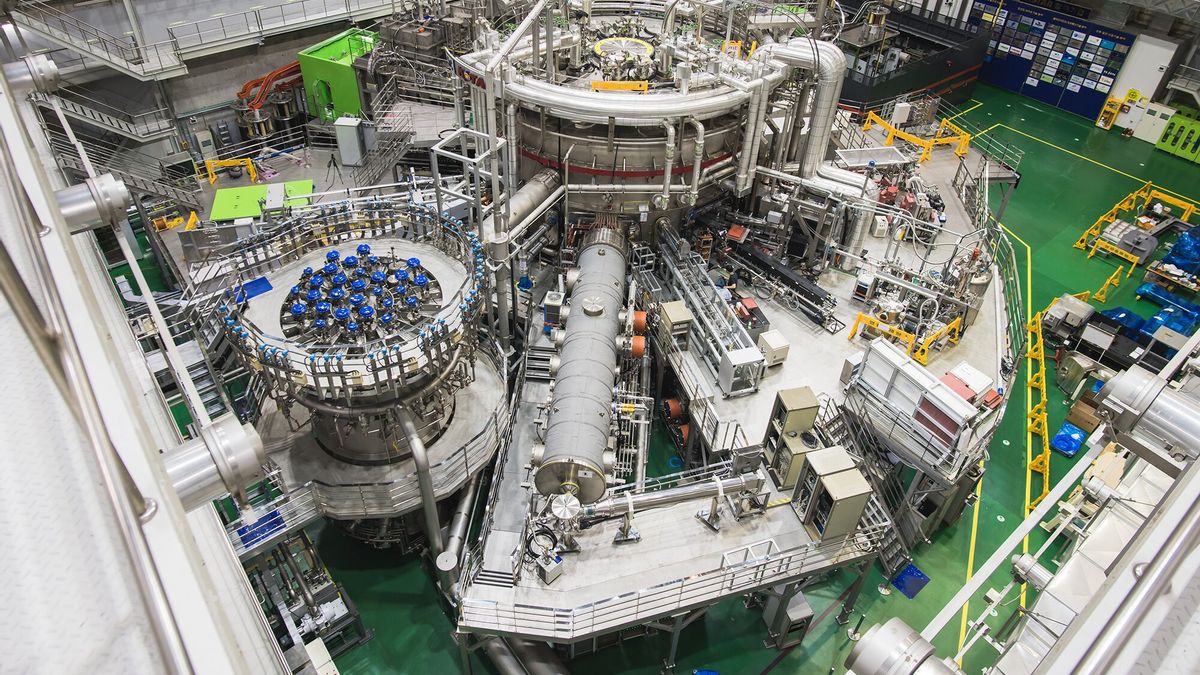JAKARTA - The latest innovation from the application of nuclear technology is to create an 'artificial sun'. This has been proven by a number of developed countries, such as China and South Korea.
The artificial sun is actually the nickname given to a large-powered nuclear fusion reactor. The project to develop an international nuclear fusion reactor has been going on since 2006.
This project has been developed by several countries that are members of the International Termonuclear Reactor (ITER) and centered in France. The aim of this project is none other than to create alternative energy sources.
So far China and South Korea have succeeded in lighting up their artificial sun. Even though it is only for a moment, the energy produced is capable of tens of times higher than the original sun.
China became the first country to successfully light the artificial sun. This Chinese-made installation is claimed to be capable of producing 10 times hotter energy than the core of the sun itself.
Reporting from the South China Morning Post page, the Chinese-made sun is operated in the Tokamak HL-2M installation which is capable of producing heat energy of up to 150 million degrees Celsius (270 million Fahrenheit). For a few seconds, China's nuclear fusion reactor can only produce the strongest electric currents between two and three mega-amps.
South Korea Sets New RecordsAs is known, the operation of nuclear fusion reactors has not operated stably for a long time. Given that the current energy generation to trigger nuclear fusion reactions is still greater than the power generated.
Previously, the Matahari installation made in China was already on. Now the South Korean sun is reported to have set a new world record, because it managed to maintain continuous plasma operation for 20 seconds with the highest ion temperature reaching more than 100 million degrees Celsius, as summarized from the phsy page, Tuesday, December 29.
The superconducting fusion device or artificial sun was developed by Korea Superconducting Tokamak Advanced Research (KSTAR), a joint study by Seoul National University (SNU) and Columbia University, United States.
KSTAR itself has carried out 110 plasma experiments since August 2020. Researchers have a target to be able to maintain the stability of nuclear fusion of 100 degrees Celsius for 300 seconds by 2025.
"We are honored to be involved in the important milestones made at KSTAR. The 100 million degree ion temperature achieved by enabling efficient heating of core plasma for long periods of time demonstrates the unique capabilities of the superconducting KSTAR device, and will be recognized as a solid basis for fused plasma. stable condition and high performance, "said Dr. Young-Seok Park of Columbia University.
The nuclear fusion device or Tokamak comes from the Russian acronym which means toroidal chamber with magnetic coils. Nuclear fusion is the joining of two atomic nuclei to form one or more large atomic nuclei.
In this research experiment, researchers used hydrogen atoms combined to form helium. The merger process emits a very high temperature, so nuclear fusion researchers must be careful and pay attention to temperature control in order to keep the nuclear fusion reaction under control.
This record is the achievement of an extension of the plasma operation time of 8 seconds during the 2019 KSTAR Plasma Campaign more than twice. In a 2018 experiment, KSTAR reached a plasma ion temperature of 100 million degrees for the first time (retention time about 1.5 seconds).
In order to recreate the fusion reactions that occur in the Sun on Earth, hydrogen isotopes must be placed in fusion devices such as KSTAR to create a plasma state where ions and electrons are separated, and ions must be heated and maintained at high temperatures.
The purpose of the Artificial Sun projectIn fact, many are wondering why South Korea is so persistent in developing this artificial sun, while the original sun can still be used for human needs.
The Korea Institute of Fusion Energy or KFE said the artificial sun is useful for reaching places where scientists have succeeded in maintaining and harnessing nuclear fusion energy to provide electricity. With this technology, it will pretty much solve mankind's energy needs.
And of course, this discovery could be useful for energy needs also around the world because with that much power it can produce energy power greater than the original sun.
"We will continue our challenge of realizing nuclear fusion energy, which is the goal of all humanity," explained Director Si-Woo Yoon of the KSTAR Research Center.
Challenges for IndonesiaIn Indonesia, research and utilization of nuclear energy is carried out by the National Nuclear Energy Agency (BATAN). It is possible that Indonesia can also develop its own solar installations.
Given that the artificial sun is claimed to be able to produce energy without limits, which is sufficient to reach areas in Indonesia. Moreover, this process is said to be safe and environmentally friendly because it does not leave radioactive waste.
The English, Chinese, Japanese, Arabic, and French versions are automatically generated by the AI. So there may still be inaccuracies in translating, please always see Indonesian as our main language. (system supported by DigitalSiber.id)













